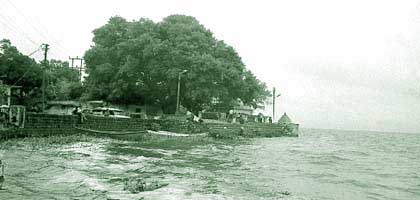 





|

Vol. 2
No.
4
August 2000
|

Hope for
Bhopal
For the deteriorating lakes, the efforts of the Bhoj Wetland Project Environmental
Planning and Coordinating Organisation may provide the proverbial shot in the arm which
may just revive these urban waterbodies. This is an effort by the Madhya Pradesh state
government and is partially supported by the Japan Bank for International Cooperation.
Bhopal is known as the city of lakes. The most important of them, the bada
and chotta lakes are together called as the Bhoj Wetland. The bada lake was
constructed in the 11th century and has a catchment area of 361 sq km and water-spread
area of 31 sq km. the chotta lake was created downstream of the bada lake in
the late 18th century. It has a small catchmant area of 9.60 sq km and a water-spread of
1.29 sq km.
The bada lake has been the drinking water source for Bhopal city for long and
has improved the groundwater recharging capacity. The bada and chotta lakes
also provides commercial occupation and commercial values by way of fishing, boating and
aquatic sports. These lakes also have religious values both for hindu and muslim
communities and are being used for idol and tazia immersion.
These lakes suffer a fate like any other urban waterbody, with the decline being
evident visibly as well as in terms of failed quality tests. Several factors contribute to
their deterioration. Contributing factors include:
 Siltation due to soil erosion and the inflow of untreated sewage
and wastewater from human settlements; Siltation due to soil erosion and the inflow of untreated sewage
and wastewater from human settlements;
 The use of the lake by more than
2,000 people daily to bathe, wash clothes and clean their vehicles; The use of the lake by more than
2,000 people daily to bathe, wash clothes and clean their vehicles;
 The immersion of idols and tazias; The immersion of idols and tazias;
 Encroachment in catchment area for
slum development and agricultural activities; and, Encroachment in catchment area for
slum development and agricultural activities; and,
 Flourishing growth of aquatic
plants; Flourishing growth of aquatic
plants;
All this has resulted in reduction of the storage capacity and water spread area and a
threat to aquatic life.
The major objectives of the BWP were to conserve and manage the Bhoj Wetlands. The
project involved several pollution control and environmental conservation measures:
1. De-silting and dredging works
This involved desilting and dredging operations, widening of the spill channel, and
restoration of the lake
Widening and deepening of the approach
channel to the spillway from the upper lake will increase the capacity of the reservoir
and act as a safety measure against floods, reducing the threats to the earthen dam
structure at Kamla Park.
2. Catchment area treatment
This involved afforestation, creation of buffer zones, construction of check dams, silt
traps, toe walls and cascading for controlling silt entry. The buffer zones will prevent
encroachment while afforestation would reduce the quantity of silt that entered these
lakes.
3. Sewerage pollution prevention schemes and construction
of garland drains around the lower lake
4. Shoreline and fringe areas
management
This meant controlling the interaction between the human population and the water bodies.
This included creating a physical barrier for controlling human and animal activities,
solid waste management and dhobi ghat pollution prevention
5. Water quality monitoring
This aimed at first controlling the pollution and then monitoring the lakes. This included
deweeding the lakes, setting up a water quality monitoring laboratory for regular
surveillance, installation of floating fountains and aquaculture. The laboratory that has
been set up is capable of screening for 120 parameters of water quality.
 |
| The bada lake in Bhopal :
source of groundwater recharge and the city’s water supply |
Source:
Aniruddhe Mukherjee, Ex-Project Director, Bhoj Wetland Project and presently is the Chief
Executive Officer, Zila Panchayat, Collectorate, Raipur, MP-492001. |
|
about us
down to earth
environmental
resources environment
and you
calendar
campaigns
HOME
FEEDBACK
GUIDED TOUR
PUBLICATIONS
SEARCH
 |
[ BIODIVERSITY |
CLIMATE CHANGE | AIR
POLLUTION | WATER POLLUTION
| RAIN WATER HARVESTING | FOREST MANAGEMENT | PEOPLE
& WILDLIFE ]
Copyright © CSE
Centre for Science and Environment |